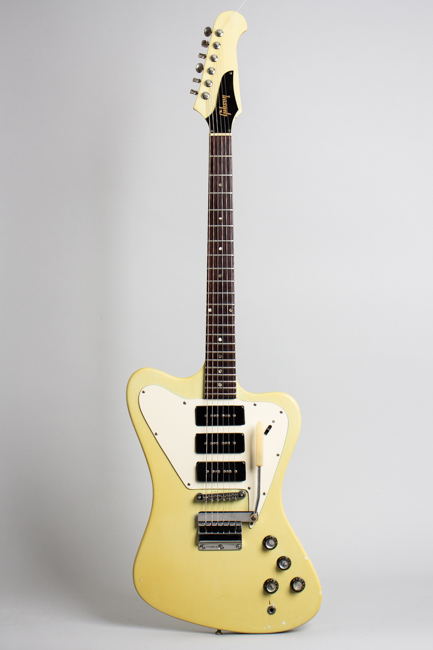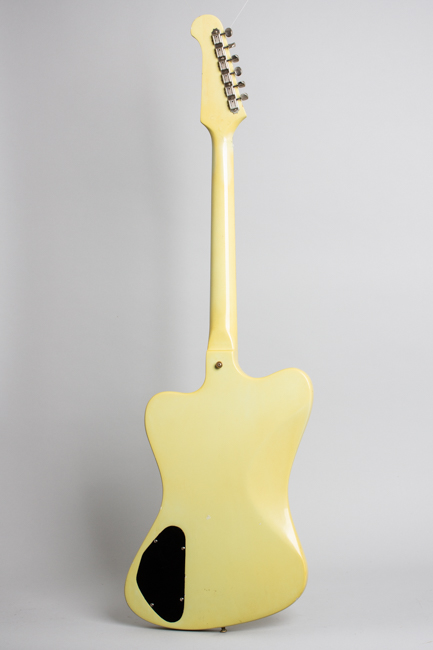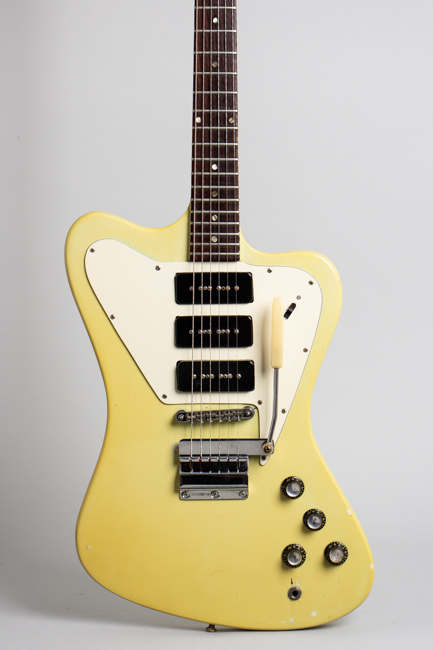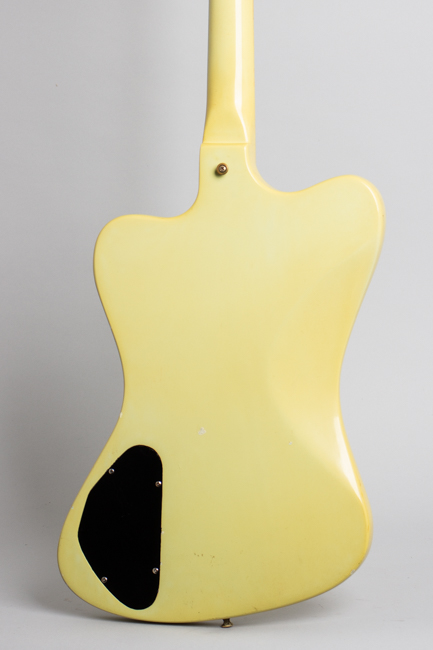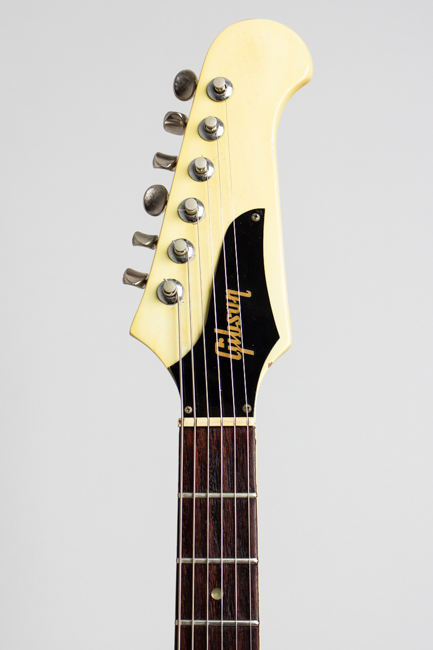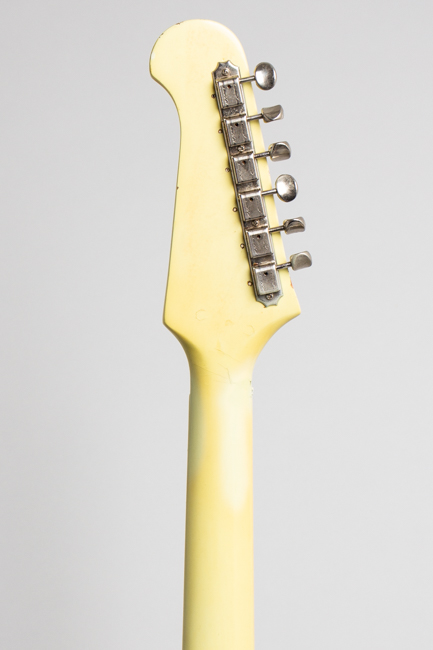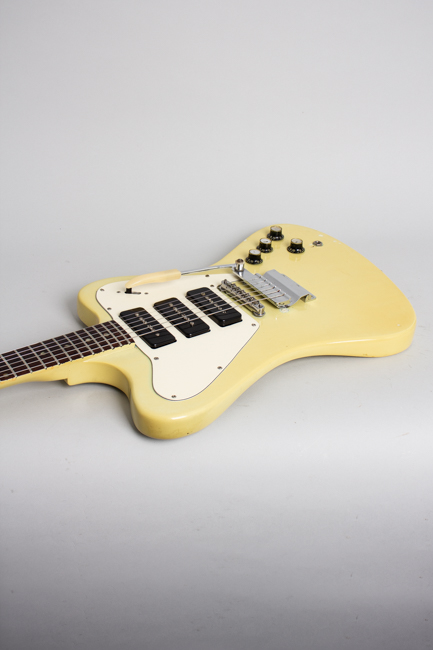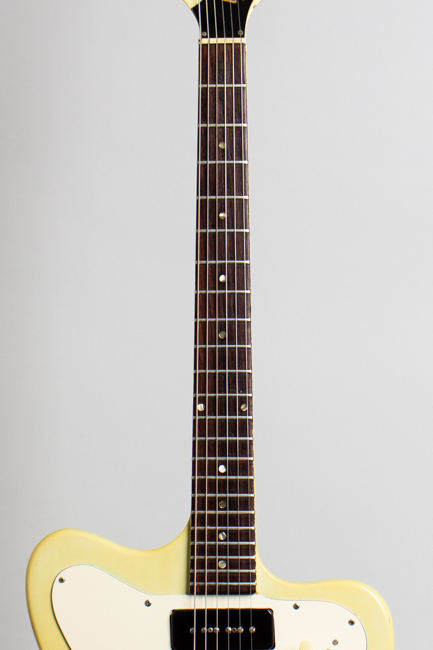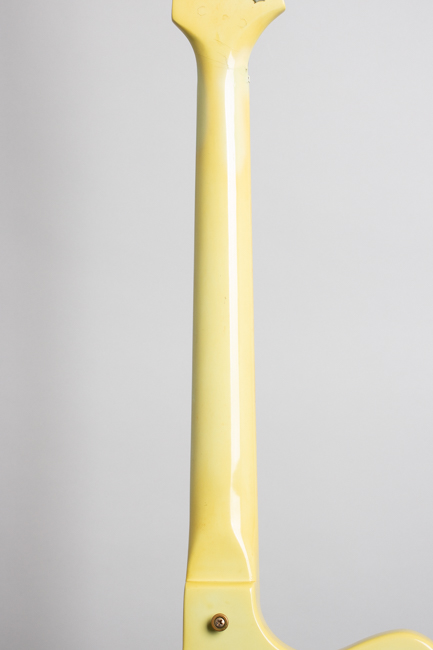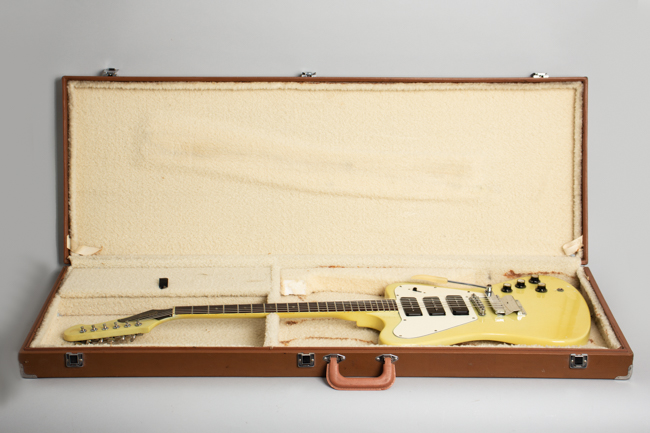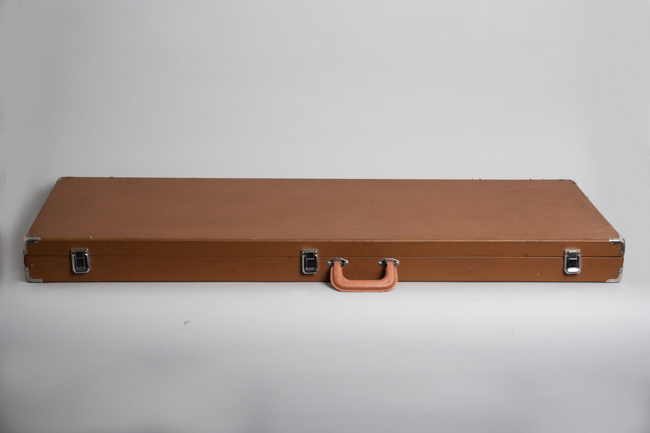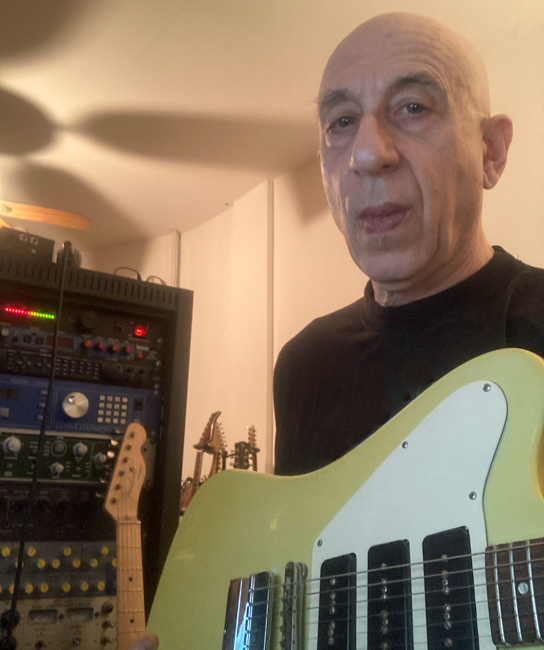Gibson Firebird III Owned and Used by Elliott Sharp Solid Body Electric Guitar , c. 1967
This item has been sold.
Item # 11680
Prices subject to change without notice.
Gibson Firebird III Owned and Used by Elliott Sharp Model Solid Body Electric Guitar, c. 1967, made in Kalamazoo, Michigan, serial # NSN, Pale Green Lacquer re- finish, mahogany body and neck, rosewood fingerboard, brown hard shell case.
This is what celebrated New York guitarist/composer Elliott Sharp told us about this Firebird: "I've owned this guitar since 1992 and believe it to have been refurbished by Peter Florance. It was gigged with rarely but used on many recordings over the years including film and theatre work, the band Terraplane and other band projects of mine. I used this guitar in a duet with Marc Ribot playing a Strat in Frank London's score for the 1993 film "The Shvitz" by Jonathan Berman. It will be heard on the upcoming Terraplane album "Livin' Here" as well on Terraplane tracks from "Do The Don't".
This pale green 'Bird is a heavily refurbished example of one of Gibson's less heralded 1960s classics, the "non-reverse" Firebird III. These lower-priced, simplified versions of the earlier "reverse" body Firebird series allowed Gibson to lower the price to better compete with Fender, the original idea. Introduced at the summer NAMM show in 1965, the new Firebirds were available through the late 1960s but never really considered a sales success.
This is a Firebird III, with 3 P-90 pickups on a sculpted mahogany body with Gibson's traditional glued-in neck. The non-reverse III is distinguished by offering this unusual combination, one Gibson had not used before on a solidbody. They are wired in the typical Gibson 3-pickup layout, with the center switch position being bridge and middle out of phase. With P-90's this gives a unique tone, sort of a "fat Strat" effect.
Originally the "short" Vibrola unit with a plastic-tipped handle was paired with a stud-mounted bridge; it is now a Tune-O-Matic. The tuners are a nickel-plated single Kluson Deluxe strip unit Gibson used only on these and some Epiphone solidbodies. The knobs are the older style with a metal cap used mostly from 1961-67, not the later "Witch Hat" type. The neck is narrower at the nut than earlier reverse Firebird necks, but still has a nice feel not quite as insubstantial-feeling as some period SG necks.
This guitar has had a headstock repair as well as the refinish, and the serial number is lost. The larger rout in the body under the pickguard indicates it was built in 1967 or 68. Aside from its unique looks this is a great-sounding guitar, with powerful P-90 pickups that really growl when cranked. The center position is an interesting sonic revelation, the traditional P-90 sound with a bit of the phased "mid-scoop" common to Stratocasters but not as cliched. The "non-reverse" Firebirds used to be discounted in Gibson history, but have found a growing cadre of enthusiasts in the 21st century. They remain distinctive guitars unlike any other in look or feel. Extremely light, fast, and super stylish, this rebuilt hot rod is a standout in any crowd.
Overall length is 43 3/8 in. (110.2 cm.), 13 7/16 in. (34.1 cm.) wide at lower bout, and 1 3/8 in. (3.5 cm.) in depth, measured at side of rim. Scale length is 24 3/4 in. (629 mm.). Width of nut is 1 9/16 in. (40 mm.).
This guitar is heavily re-worked from original but still retains the classic non-reverse Firebird feel and sound. The body and neck were long ago refinished to a striking pastel shade we can best describe as avocado green; it has yellowed to a more citron-y look from the bluer hue it was once redone to. There is a very old headstock repair, solid but visible with what look like a couple of pegs added through the headstock and some old shrinkage in the lacquer over some of the repaired spots. This has been solid for well over 30 years now. There are some dings, dents and chips to the finish with some touched up spots here and there. The area around the jack shows some chipping.
The hardware fitted is mostly of later vintage later than the guitar, although everything dates no later than 1992. All three pickups are aftermarket; the lead pickup is a double magnet Seymour Duncan while the other two are unmarked later P-90s; all the wiring is later as well, although oddly enough the oft-replaced slider switch appears to be original, as are the knobs. The wiring is stock except the middle (instead of bridge) pickup is selected solo in the lowest switch position, resulting in a more powerful honk than usual.
The bridge is an older Gibson Tune-O-Matic (the guitar had a bar bridge originally) with the original vibrato tailpiece. At some point after the refinish a stop tailpiece was fitted, for which filled holes can be seen. The pickguard is aftermarket with no bird logo, but in the correct shape. An external ground wire has been added from the pickups to the bridge post.
The original style strip Kluson tuners have been restored to the headstock (with visible screw holes from something else previously there) and the truss rod cover is a repro. The guitar looks to have been refretted some time back, and is an excellent player with a very supple action. While a long way from its original state, this guitar is an excellent player retaining the classic appearance and sound of the P-90 Firebird. Elliott tells us the guitar has served him well for over 30 years, and is ready for a new home. It is housed in a serviceable if not perfectly fitted Explorer HSC. Restored to Excellent Condition.
This is what celebrated New York guitarist/composer Elliott Sharp told us about this Firebird: "I've owned this guitar since 1992 and believe it to have been refurbished by Peter Florance. It was gigged with rarely but used on many recordings over the years including film and theatre work, the band Terraplane and other band projects of mine. I used this guitar in a duet with Marc Ribot playing a Strat in Frank London's score for the 1993 film "The Shvitz" by Jonathan Berman. It will be heard on the upcoming Terraplane album "Livin' Here" as well on Terraplane tracks from "Do The Don't".
This pale green 'Bird is a heavily refurbished example of one of Gibson's less heralded 1960s classics, the "non-reverse" Firebird III. These lower-priced, simplified versions of the earlier "reverse" body Firebird series allowed Gibson to lower the price to better compete with Fender, the original idea. Introduced at the summer NAMM show in 1965, the new Firebirds were available through the late 1960s but never really considered a sales success.
This is a Firebird III, with 3 P-90 pickups on a sculpted mahogany body with Gibson's traditional glued-in neck. The non-reverse III is distinguished by offering this unusual combination, one Gibson had not used before on a solidbody. They are wired in the typical Gibson 3-pickup layout, with the center switch position being bridge and middle out of phase. With P-90's this gives a unique tone, sort of a "fat Strat" effect.
Originally the "short" Vibrola unit with a plastic-tipped handle was paired with a stud-mounted bridge; it is now a Tune-O-Matic. The tuners are a nickel-plated single Kluson Deluxe strip unit Gibson used only on these and some Epiphone solidbodies. The knobs are the older style with a metal cap used mostly from 1961-67, not the later "Witch Hat" type. The neck is narrower at the nut than earlier reverse Firebird necks, but still has a nice feel not quite as insubstantial-feeling as some period SG necks.
This guitar has had a headstock repair as well as the refinish, and the serial number is lost. The larger rout in the body under the pickguard indicates it was built in 1967 or 68. Aside from its unique looks this is a great-sounding guitar, with powerful P-90 pickups that really growl when cranked. The center position is an interesting sonic revelation, the traditional P-90 sound with a bit of the phased "mid-scoop" common to Stratocasters but not as cliched. The "non-reverse" Firebirds used to be discounted in Gibson history, but have found a growing cadre of enthusiasts in the 21st century. They remain distinctive guitars unlike any other in look or feel. Extremely light, fast, and super stylish, this rebuilt hot rod is a standout in any crowd.
Overall length is 43 3/8 in. (110.2 cm.), 13 7/16 in. (34.1 cm.) wide at lower bout, and 1 3/8 in. (3.5 cm.) in depth, measured at side of rim. Scale length is 24 3/4 in. (629 mm.). Width of nut is 1 9/16 in. (40 mm.).
This guitar is heavily re-worked from original but still retains the classic non-reverse Firebird feel and sound. The body and neck were long ago refinished to a striking pastel shade we can best describe as avocado green; it has yellowed to a more citron-y look from the bluer hue it was once redone to. There is a very old headstock repair, solid but visible with what look like a couple of pegs added through the headstock and some old shrinkage in the lacquer over some of the repaired spots. This has been solid for well over 30 years now. There are some dings, dents and chips to the finish with some touched up spots here and there. The area around the jack shows some chipping.
The hardware fitted is mostly of later vintage later than the guitar, although everything dates no later than 1992. All three pickups are aftermarket; the lead pickup is a double magnet Seymour Duncan while the other two are unmarked later P-90s; all the wiring is later as well, although oddly enough the oft-replaced slider switch appears to be original, as are the knobs. The wiring is stock except the middle (instead of bridge) pickup is selected solo in the lowest switch position, resulting in a more powerful honk than usual.
The bridge is an older Gibson Tune-O-Matic (the guitar had a bar bridge originally) with the original vibrato tailpiece. At some point after the refinish a stop tailpiece was fitted, for which filled holes can be seen. The pickguard is aftermarket with no bird logo, but in the correct shape. An external ground wire has been added from the pickups to the bridge post.
The original style strip Kluson tuners have been restored to the headstock (with visible screw holes from something else previously there) and the truss rod cover is a repro. The guitar looks to have been refretted some time back, and is an excellent player with a very supple action. While a long way from its original state, this guitar is an excellent player retaining the classic appearance and sound of the P-90 Firebird. Elliott tells us the guitar has served him well for over 30 years, and is ready for a new home. It is housed in a serviceable if not perfectly fitted Explorer HSC. Restored to Excellent Condition.
